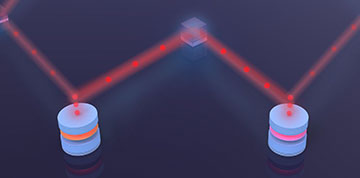
The USTC team has shown that single photons emitted by two independent quantum dots can demonstrate quantum inference over hundreds of kilometers. [Image: X. You, USTC]
An international team of scientists has demonstrated a scalable photonics platform that offers a promising route toward long-distance quantum communications (Adv. Photon., doi: 10.1117/1.AP.4.6.066003). Led by Jian-Wei Pan at the University of Science and Technology of China (USTC), the researchers designed a solid-state system that generates quantum interference between two independent photons over an optical fiber longer than 300 km—two orders of magnitude further than has been achieved with equivalent solutions.
Syncing photons
At the heart of the experimental set-up are two single-photon sources made from quantum dots, favored for their ease of integration and more controllable light emission. Each quantum dot is coupled to a microcavity to generate single photons more efficiently and to ensure that the emitted photons are indistinguishable from each other. Pumping the quantum dots with the same laser synchronizes the emission, while additional optical elements guarantee that the two independent photons have the same polarization.
The self-assembled quantum dots emit light at slightly different wavelengths in the near-infrared, which need to be shifted to exactly the same frequency in the telecommunications band to enable both quantum interference and low-loss transmission. To maintain the characteristics of the single photons, the team devised a quantum frequency conversion process that exploits two pump lasers precisely tuned to different wavelengths, yielding single-photon emission from both quantum dots at exactly 1582.75 nm and with an overall conversion efficiency of around 50%.
A schematic illustrating the experimental configuration that the researchers used. [Image: You et al., doi: 10.1117/1.AP.4.6.066003] [Enlarge image]
The pair of independent photons produced by the scheme demonstrates clear quantum interference over fiber distances of up to 300 km, with interference visibility of 67%—well above the classical limit of 50%. Temporal filtering further boosts the figure to 93%, the highest yet reported for a solid-state system.
What’s more, by making just a few refinements to the experimental set-up, the researchers are confident that they can extend the interference distance to around 600 km. “Using tunable open microcavities, it is feasible for the single-photon system efficiency to reach 80%,” comments senior author and USTC professor Chao-Yang Lu. “In addition, optical fiber with an ultralow transmission loss of 0.16 dB/km has become available.”
“An important step”
The researchers believe that their experimental platform offers a useful blueprint for quantum communications networks that could enable quantum key distribution between multiple users and long-distance quantum teleportation. The platform also offers the potential to generate large numbers of entangled photons, which would provide a useful resource for all-optical quantum repeaters and distributed quantum computing. “Our work represents an important step toward quantum telecommunication networks using semiconductor quantum dots and telecom fiber channels,” Lu concludes.

